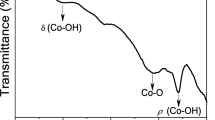Abstract
Bare tin-doped indium oxide (ITO) and fluorine-doped tin oxide (FTO), which are widely used transparent conducting metal oxide as anode materials for various electrochemical applications, are not used as anode materials for photoelectrochemical (PEC) oxidation of water as those required high potential to obtain efficient oxidation of water. To reduce the oxidation potential, tedious modification with photoelectrocatalyst is required. A straightforward alternative of using the modified electrode would be established if any bare metal oxide could be used as an efficient electrode material for water oxidation. Here, we report for the first time that commercially available bare gallium doped zinc oxide (GZO) has great potential to be utilized as an anode material for efficient PEC water oxidation at low potential under UV–Vis light. The higher performance of GZO was revealed by comparing the PEC behavior of other commercially available and frequently employed transparent conductive metal oxide electrodes, namely, ITO, FTO, and aluminum-doped zinc oxide. The GZO and AZO show the highest and second highest water oxidation signal, respectively, among the tested electrodes. Moreover, the GZO shows higher stability as compared to AZO under applied experimental conditions. ITO electrode also exhibited a good stability but its efficacy towards water oxidation was the lowest. The efficiency of the GZO toward PEC water oxidation at 0.6 V is ca. 36.5 times higher than that obtained at ITO.





Similar content being viewed by others
References
M. Qamar, Q. Drmosh, M.I. Ahmed, M. Qamaruddin, Z.H. Yamani, Nanoscale Res. Lett. 10, 1–6 (2015). doi:10.1186/s11671-015-0745-2
D. Gust, T.A. Moore, A.L. Moore, Acc. Chem. Res. 42, 1890–1898 (2009)
X. Chen, Z. Zhang, L. Chi, A.K. Nair, W. Shangguan, Z. Jiang, Nano-Micro Lett. (2015). doi:10.1007/s40820-015-0063-3
Z. Chen, A.R. Rathmell, S. Ye, A.R. Wilson, B.J. Wiley, Angew. Chem. Int. Ed. 52, 13708–13711 (2013). (and references therein)
P. Chatchai, Y. Murakami, S.-Y. Kishioka, A.Y. Nosaka, Y. Nosaka, Electrochem. Solid-State Lett. 11, H160–H163 (2008)
C. Cheng, H. Zhang, W. Ren, W. Dong, Y. Sun, Nano Energy 2, 779–786 (2013)
F. Zhou, C. McDonnell-Worth, H. Li, J. Li, L. Spiccia, D.R. Macfarlane, J. Mater. Chem. A 3, 16642–16652 (2015)
M. Fekete, W. Ludwig, S. Gledhill, J. Chen, A. Patti, L. Spiccia, Eur. J. Inorg. Chem. 2014, 750–759 (2014)
S. Sohila, R. Rajendran, Z. Yaakob, M.A.M. Teridi, K. Sopian, J. Mater. Sci.: Mater. Electron. 27, 2846–2851 (2016)
M. Fekete, W. Riedel, A.F. Patti, L. Spiccia, Nanoscale 6, 7585–7593 (2014)
R. Gutkowski, D. Schafer, T.C. Nagaiah, J.E.Y. Heras, W. Busser, M. Muhler, W. Schuhmann, Electroanalysis 27, 285–292 (2015)
D.K. Bora, A. Braun, RSC Adv. 4, 23562–23570 (2014)
F.O. Bakare, W. Mahfoz, M.A. Aziz, M.N. Shaikh, A.S. Hakeem, M. Oyam, Z.H. Yamani, J. Electrochem. Soc. 163, H24–H29 (2016)
Z.C. Chang, S.C. Liang, Mater. Metall. Eng. 8, 422–424 (2014)
M.A. Aziz, M. Sohail, M. Oyama, W. Mahfoz, Electroanalysis 27, 1268–1275 (2015)
M.I. Ahmed, M.A. Aziz, A. Helal, M.N. Shaikh, J. Electrochem. Soc. 163, D277–D281 (2016)
C.C.P. Cid, E.R. Spadaa, M.L. Sartorelli, Appl. Surf. Sci. 273, 603–606 (2013)
C.-H. Hsu, D.-H. Chen, Nanoscale Res. Lett. 7, (2012) http://www.nanoscalereslett.com/content/7/1/593
S. Tabassum, E. Yamasue, H. Okumura, K.N. Ishihara, J. Mater. Sci.: Mater. Electron. 25, 4883–4888 (2014)
Acknowledgments
The authors acknowledge the funding support from King Abdulaziz City for Science and Technology (KACST) through the Science & Technology Unit at King Fahd University of Petroleum & Minerals (KFUPM): Project No. 14-ENV332-04, as part of the National Science, Technology and Innovation Plan.
Author information
Authors and Affiliations
Corresponding authors
Rights and permissions
About this article
Cite this article
Aziz, M.A., Ahmed, M.I., Qamar, M. et al. Photoelectrochemical investigation of bare transparent conducting oxides for water oxidation. J Mater Sci: Mater Electron 27, 10325–10329 (2016). https://doi.org/10.1007/s10854-016-5116-y
Received:
Accepted:
Published:
Issue Date:
DOI: https://doi.org/10.1007/s10854-016-5116-y




